 A few weeks ago I posted about events at Saint Louis University. Since then we have been told that the executive committees of the Faculty Senate and the Trustees are talking to one another; but the discussions (if indeed there are such) are being kept secret on the advice of Fleishman-Hillard, a high-priced PR firm the Trustees have retained to help them manage the crisis on campus. Reasonably good summaries of recent events at SLU may be found here and here.
A few weeks ago I posted about events at Saint Louis University. Since then we have been told that the executive committees of the Faculty Senate and the Trustees are talking to one another; but the discussions (if indeed there are such) are being kept secret on the advice of Fleishman-Hillard, a high-priced PR firm the Trustees have retained to help them manage the crisis on campus. Reasonably good summaries of recent events at SLU may be found here and here.
The SLU faculty have now produced a report detailing grievances against the University President and Vice President for Academic Affairs. It reveals the dark side of Saint Louis University with which inslders have always been familiar but which has until recently been hidden from the public at large. It’s good to see this excellent report, produced by many hands, some of whom have chosen to remain anonymous out of fear of reprisal. That discretion is well-advised, as we have it on good authority that enemies lists are presently being drawn up and punishments prepared. But the SLU faculty seem to have united after years of abuse during which the careers of those who have opposed the tyranny have been wrecked, their salaries frozen or lowered, their requests for earned leaves denied, their travel funds withheld—and that’s only the surface. By far the worst part of being punished at Saint Louis University is that one becomes a pariah, marginalized in one’s own department, shunned by colleagues and former friends. This excellent faculty report is most welcome—it’s just a good many years too late, perhaps permanently too late with respect to collegial relationships that have been destroyed.
Post Dispatch columnist, Bill McClellan, has referred to Fleishman-Hillard as “mess Busters” in a recent column, not failing to note that the firm is also consulting for the embattled Missouri HIstory Museum in the midst of scandal over a dubious land purchase. The cases are similar in that both involve secretive executives, captive boards, and official stonewalling in the face of public criticism. But there’s been no suggestion of graft at SLU, at least so far, though some prominent trustees regularly do business with the university. And McClellan, himself, points to another difference: “Unlike the History Museum, SLU is a private institution. [Trustee President Thomas H.] Brouster does not have to communicate with the public.”
But SLU does have to communicate with accrediting agencies. The SLU law school is presently out of compliance with a number of accreditation standards relating to President Biondi’s high-handed appointment of interim law dean, Thomas Keefe. And on another front an instructive parallel might be drawn with the University of Virginia, whose board’s high-handed firing of President Teresa Sullivan six months ago has now occasioned a warning from the Southern Association, citing the board for “compromising the university’s integrity, not having a formal policy for involving faculty in making decisions and not following its governance requirements, which forbid a small number of members from controlling the board”—ethical and governance violations that are only too familiar to members of the academic community at Saint Louis University.
The SLU Trustees meet this Saturday, December 15. SLU Students for No Confidence are sponsoring a march. We’ll see what happens.
